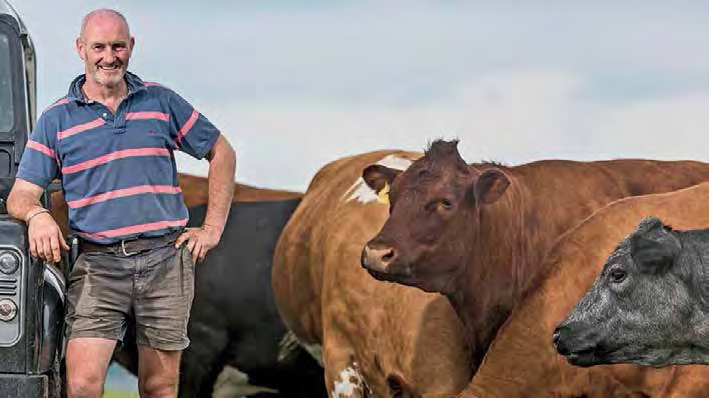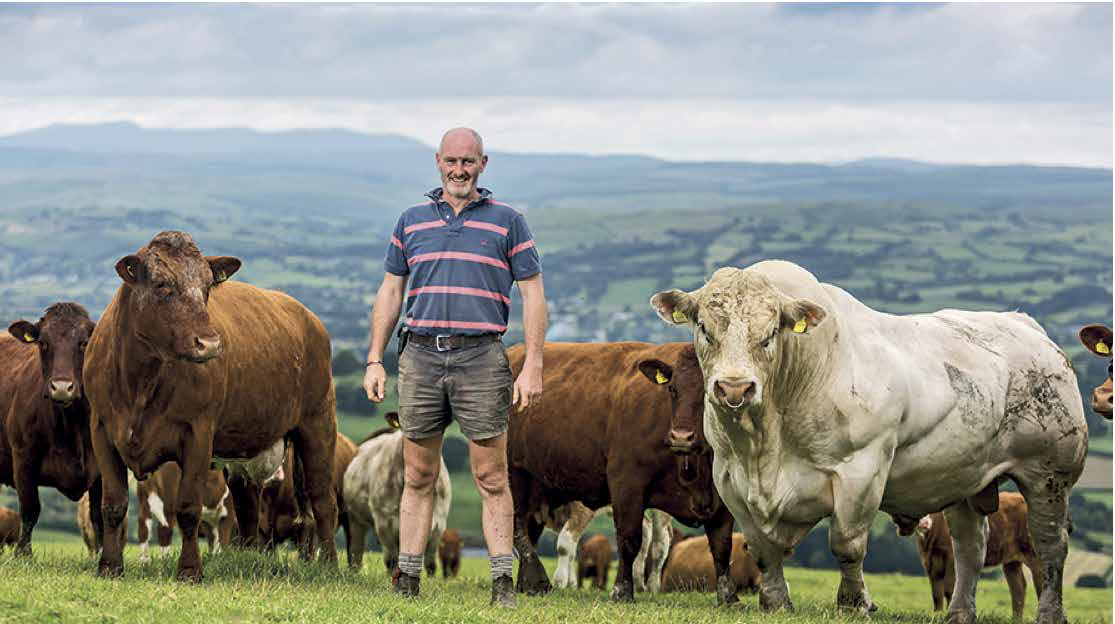Richard Tudor is a shining example of how to operate a profitable upland beef enterprise. He is making the most of every morsel of land for his spring-calving, 140-cow suckler herd to generate outstanding gross margins of £704 a cow – £100 above the best Welsh upland farms on average.
THE JUDGES LIKED
Outstanding grassland management
Exceptional calf growth rates
Strong focus on herd fertility enabling the herd to achieve incredible conception rates
Calving heifers at two and carrying out pelvic measurements Using high-scoring estimated breeding value bulls
Having grown the business by almost 200ha since returning home after graduating from Aberystwyth University in 1998, Richard has placed a strong focus on herd fertility and is perfecting his breeding programme to develop a medium-sized cow that will thrive in upland conditions.
The original herd of Welsh Blacks has been slowly transitioned into a 140-cow herd of Simmental cross Salers cows, but recognising his cows’ mature size was getting too big for his upland farm, Richard has more recently introduced an Angus.
Salers heifers are put to an Angus bull to breed replacements. Half of the main herd is crossed to a high-index, terminal-sire Charolais bull within the top
5% of the breed for 200-day weights, while bigger, Simmental-type cows are put to a Salers. Richard believes fertility is key to enhancing calf performance.
“I am trying to increase my conception rates because that’s the easiest way to increase my weaning weights,” says Richard, who adds that tightening his calving pattern also means it’s easier to group calves for sale.
Through his strong focus on fertility and rigorous breeding checks, Richard is achieving unbelievable conception rates, with 75% of the herd calving in the first three weeks of the calving period and 90% in six weeks, which he says is vital to his store selling enterprise.
In order to make it into the herd, heifers must be born from cows that calved in the first cycle. They undergo pelvic area measurements and get fertility scored ahead of service in January when they are synchronised and AI’d to an American Angus, chosen for its short gestation length, daughter’s milking ability and structural soundness.

FARM FACTS
290ha upland farm plus 20ha rented 140 spring-calving cows plus 1,200 ewes and 300 lambs
High health status – bovine viral diarrhoea accredited and infectious bovine rhinotracheitis negative Texel-cross lambs finished off on grass and sold to Waitrose 98% of calves born alive a cow scanned
A strong team of bulls is used in the main herd, with cows run in groups of 25 a bull in the first cycle to maximise first-service conception rates, before being mobbed into larger groups of 50 in the second. All bulls are subject to annual semen tests.
This approach to maximising herd fertility, combined with Richard’s focus on high 200-day weight estimated breeding values (EBVs), is contributing to phenomenal calf performance, with April-born steers and heifers averaging daily liveweight gains of 1.53kg up to weaning.

This figure is even more impressive when you consider calves are fed a forage-based diet alone up to weaning in October, when cows are housed in cubicles and calves have access to creep and goodquality silage.
The aim is to sell steers and heifers as 10- and 18-month-old stores at Welshpool market in February and October, although 10% – those he isn’t happy to sell as stores – are sold direct to ABP, averaging 348kg carcass weights.
Richard says selling stores enables him to keep feed costs low by reducing the amount of purchase feed required.
This is further helped by his attention to detail when it comes to grassland management.
To make the best use of his poorer-quality hill ground, where land rises to 425m, annual soil sampling is carried out and he rotational grazes mixed stock.
“On the hill ground, the aim is to keep the pH, K and P right and the cattle manage the grass,” explains Richard.
More recently, a further 20ha has been acquired on a five-year agreement at a competitive rent and this has been sown with a hybrid mix of plantain, grass, kale and rape for winter-grazing sheep.
About 20ha is reseeded annually and on lower-lying ground Richard is using a mixture of herbal grass leys and plantain.
Meanwhile, high-sugar grass and white clover varieties are grown to make high-energy silage for the winter.
This year Richard’s became the first farm in the UK to grow Fixation – a high protein and deep-rooting clover variety that originates from Oregon, US – which he is trialling as part of his role as a demonstration farm for Farming Connect.
As well as this, Richard sits on the NFU Welsh livestock board and the Hybu Cig Cymru research and development committee.
The Farmers Weekly Beef Farmer of the Year 2016 award is sponsored McDonald’s. “The sustainability of the beef industry is crucial to a business such as ours, and these finalists show how attention to detail in management and a focus on the end customer can deliver that sustainability”
CONNOR MCVEIGH

THE ULTIMATE SUCKLER BREED
Previous slide
Next slide
BEEF FARMER OF THE YEAR – RICHARD TUDOR
Facebook
Twitter
LinkedIn
Pinterest
Salers Cattle Society of the UK
Pepperwell, Castle Farm, Methven, PH1 3SU
T: 07903 626249
VAT Reg No: 625 3266 49
Registered Address: Lane Farm , Milnthorpe, LA7 7NH
T: 01539 567804
Company Reg No: 01892440 Charity No: 1115115
